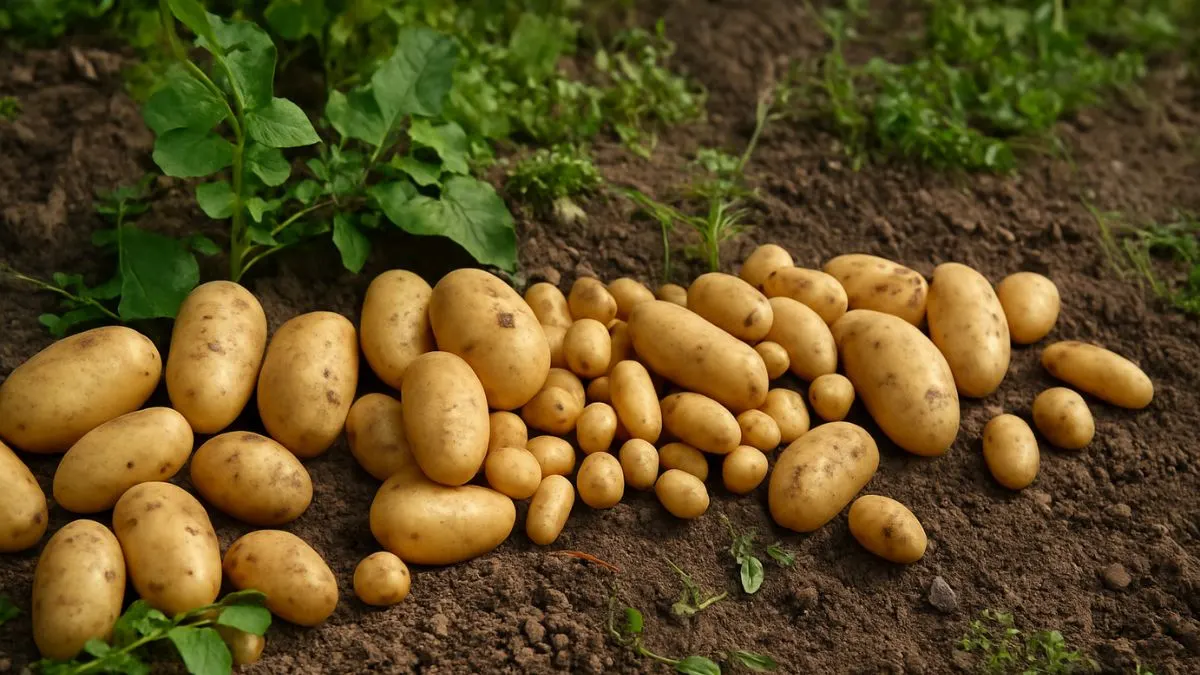Few vegetables feel as rewarding to grow at home as potatoes. They’re not only versatile in the kitchen but also surprisingly easy to cultivate. From mashed potatoes to crispy fries, nothing beats the taste of freshly dug spuds. Even if you’re short on space, they adapt beautifully to containers, grow bags, or raised beds.
1. Choosing the Right Potato Variety

Before planting, decide on the type of potato you want to grow.
- Early potatoes: Harvested quickly, perfect for new gardeners.
- Maincrop potatoes: Larger yields, great for storage.
- Specialty potatoes: Purple, red, or fingerling varieties for a gourmet touch.
Choose varieties suited to your climate—cooler regions like Canada or northern USA benefit from early types, while warmer zones can try both early and maincrop.
2. Preparing the Soil
They thrive in fertile, well-drained soil.
- Always prepare a bed in well-drained soil in full sun for the best results.
- Mix in compost or aged manure to enrich the soil.
- Aim for a slightly acidic pH of 5.5–6.5.
Raised beds or loose garden soil work best because tubers need room to expand underground.
Also Read: Plumeria: The Sacred Flower Hiding in Plain Sight”
3. When to Plant Potatoes
Timing is crucial for a good harvest.
- Garden potatoes can be planted 2 to 4 weeks before the average last frost date.
- In cooler regions, wait until the soil warms to at least 45°F (7°C).
- In warmer climates, you can plant twice a year—spring and fall.
This timing ensures plants get a head start before summer heat or winter frost.
4. Planting Potatoes
Here’s the fun part—getting those tubers into the soil.
- Start with certified seed potatoes (not grocery store potatoes).
- Cut large tubers into smaller chunks with at least 2 eyes each.
- Plant sprouted seed potato pieces with their eyes facing up in sunlit, loose soil, either in a garden bed or container.
- Space seed potatoes 12–16 inches apart in rows or hills.
- Make sure a single layer of seed potatoes are planted at a depth of 4 inches.
Pro Tip: If growing in containers, choose at least a 10–15 gallon grow bag or pot. They need depth and space to form properly.
5. Watering and Fertilizing
Consistent care helps them grow plump and healthy.
- Water evenly, especially during flowering when tubers form.
- Avoid overwatering; soggy soil causes rot.
- Side-dress with compost or balanced fertilizer midway through the season.
I’ve found that deep watering twice a week works best, especially during hot summers.
6. Hilling for Bigger Harvests
They don’t just grow downward; they grow upward as well.
- When plants reach 6–8 inches tall, mound soil or mulch around the stems.
- Repeat this process every 2–3 weeks.
- This protects developing tubers from sunlight and encourages more production.
Skipping hilling often results in green, inedible potatoes exposed to light.
Also Read: Grow These 7 Edible Plants in Just Water—No Soil, No Mess!
7. Growing Potatoes in Containers
Not everyone has a big yard, but that doesn’t mean you can’t enjoy them.
- Use grow bags, large pots, or buckets with drainage holes.
- Layer soil, seed potatoes, and more soil as plants grow.
- Containers make harvesting incredibly easy—just tip them over and collect them!
This method is ideal for urban gardeners in apartments or small backyards.
8. Common Pests and Diseases
Potatoes are hardy but not immune to trouble.
- Colorado potato beetles: Handpick or use organic neem spray.
- Blight: Rotate crops yearly and avoid wetting leaves.
- Wireworms: Avoid planting potatoes in newly turned sod.
Crop rotation and healthy soil management are your best defenses.
9. Harvesting
When to harvest depends on the variety you’ve planted.
- Early potatoes: Harvest 60–70 days after planting.
- Maincrop potatoes: Harvest 90–120 days after planting.
- Once plants flower and leaves start yellowing, it’s a sign tubers are ready.
Gently dig around the plant with a garden fork or hand tool. Be careful—tubers bruise easily.
10. Storing
To keep them fresh longer:
- Cure them by laying them in a dark, well-ventilated place for 1–2 weeks.
- Store in a cool (45–55°F), dark location.
- Avoid storing near onions, as they release gases that spoil them faster.
Properly cured and stored, homegrown potatoes can last for months.
Also Read: Plant Once, Enjoy Every Spring: The Magic of Sweet William
Quick Potato Growing Guide (Table)
Factor |
Requirement |
Planting Depth |
4 inches deep, eyes facing up |
Spacing |
12–16 inches apart in rows or hills |
Sunlight |
Full sun, well-drained soil |
Planting Time |
2–4 weeks before average last frost date |
Watering |
1–2 inches weekly, deep and consistent |
Harvest |
60–120 days depending on variety |
Potatoes are one of the easiest and most rewarding crops for beginners. So, grab your seed potatoes this season and enjoy the satisfaction of digging up your very own homegrown spuds.






